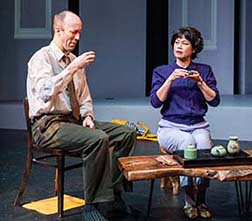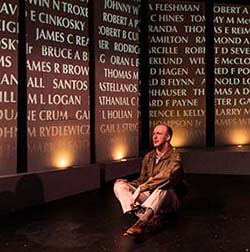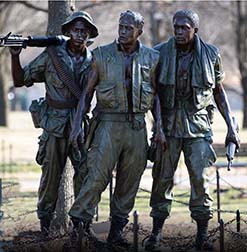
Lucy Komisar
|
“Memorial” dodges cause of conflict over Vietnam Veterans monument "Memorial" “Memorial” purports to be the story of how young architect Maya Lin got the U.S. government to build her design of a Washington Mall memorial to the U.S. veterans of the American war against Vietnam.
I was first put off when I read in the playbill that the characters were fictionalized, composites of an architect critic, a military officer, a Japanese artist, even Maya Lin and her mother. I don’t like fake docudramas that are presented as true. But then my problem went deeper. It was that the essential political narrative of what occurred is evaded, covered over, not told. The play turns on the story of architecture student Maya Lin, 21, who enters a contest for the design. Maya Lin made a statement with a series of black slabs, massive gravestones engraved with the names of the nearly 60,000 Americans who died in the war. (Nancy Ma, who I saw perform, shares the role with Angel Lin, but is not in production photos.) The set backdrop by Sheryl Liu is impressive.
lf von Eckhart (Robert Meksin), a German-born architecture critic at the Washington Post, likes Maya Lin’s design. His view about war and its victims is honed by his experience in Nazi times. A Pentagon officer, Col. James Becker (James Patrick Nelson) first promotes the memorial, then opposes it. He reveals he was shot down in Vietnam. Intended or not, Nelson’s Becker is a caricature of the military men who have traveled the world to kill people the U.S. declares enemies, though they never threatened America, then complain if they are captured. Hideo Sasaki (Glenn Kubota) is a Japanese-American artist supposedly relating to Maya Lin as a fellow Asian. We learn that he spent four years in a U.S. internment camp during World War II, but the characters don’t make a connection between the anti-Asian racism he suffered and America’s war in Vietnam. Nancy Ma is persuasive as Maya Lin, a naïve college kid who becomes sophisticated in combat against the war’s defenders in Congress. Rachel Lu as her mother Julia exudes intelligence. I liked Julia Lin’s tea ceremony with Becker, a subtle way of challenging American sense of cultural superiority. I don’t know if it’s the acting or Jeff Liu’s directing, but the women are more believable than the male actors.
However, the essential failure of the play is that writer Livian Yeh never deals with the conflict over Maya Lin’s design, which is the missing heart of the story. It is a conflict that went to the floor of Congress, which the play refers to but doesn’t explain. Was it some aesthetic problem? No, it was about the war. Should the memorial be a solemn recitation of the names of the dead to remind people of the cost of America’s wars or, as the third-place memorial competition winner had it, three unidentified soldiers, of course of diverse ethnicities, to focus on the heroic fighters. Should the monument be about glorifying the war’s killers or remembering its bloodied victims? Traditionally, military memorials going back centuries have been macho men on horseback. Then more modern, the Iwo Jima statue based on a news photograph of five Marines and one Navy corpsman raising the American flag on an island south of Tokyo. All celebrate admirable warriors. The opponents said Maya Lin’s design was a monument to defeat. Yes, of course it was, the U.S. was defeated, routed by peasants in sandals. But the military and its promoters prefer to focus on glorious “heroes” instead of the thousands of ordinary citizens who came home in body bags and who they preferred to keep uncounted and nameless. (In subsequent wars of aggression, in Iraq and Afghanistan, the U.S. banned press access to returning military coffins.)
So, though her design was the unanimous first place choice of the jurors, among 1442 entries, the war’s cheerleaders promoted the design that got third place – a kitchy bronze of three soldiers, of course white, black, Hispanic. No Asians to be depicted as killing other Asians. It was 1981, the Reagan years. Attacks on Maya Lin, cited in the play, demeaned her as “an egg roll,” and with “slanty eyes.” Critic Elizabeth Wolfson writes a good analysis in Art21. https://magazine.art21.org/2017/03/15/the-black-gash-of-shame-revisiting-the-vietnam-veterans-memorial-controversy/ She describes the “black granite, polished to a reflective smoothness (instead of white limestone or marble); its horizontal orientation, submerged into the earth instead of rising vertically; and its lack of any figurative ornamentation or any embellishment at all, save for the chronological listing of names of soldiers killed in the course of the war, etched into the granite’s mirror-like surface.” She says, “Many veterans, politicians, critics, and the general public read its refusal to explicitly glorify the war or frame the listed soldiers’ sacrifice in recognizably heroic terms as an ideological statement, proof of Lin’s—and the memorial’s—purported anti-war position.”
They attacked it as “a monument to defeat, one that spoke more directly to a nation’s guilt than to the honor of the war dead and the veterans.” Well yes, so it was, a reminder to what follows hubris and imperialist adventures. The compromise: not only was Frederick Hart’s “heroes” statue included at the memorial site, but a pole flying a U.S. flag was added. So, visitors are confronted with America’s “glorious” killers and some of their victims — only the Americans, not the Vietnamese dead. In 1995, Vietnam released its official estimate of the number of Vietnamese killed during the war: as many as 2,000,000 civilians on both sides and some 1,100,000 North Vietnamese and Viet Cong fighters. Maya Lin should do a memorial for the Vietnamese killed in the American war that ravaged their country. A war that in American memory is still being fought. Visit Lucy’s website http://thekomisarscoop.com/ |
| museums | NYTW mail | recordings | coupons | publications | classified |





